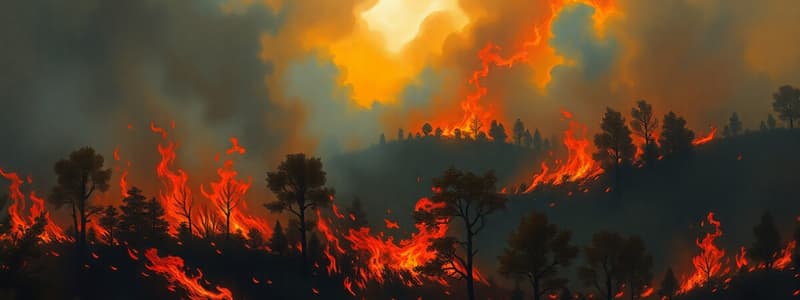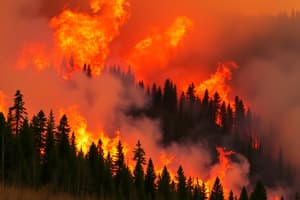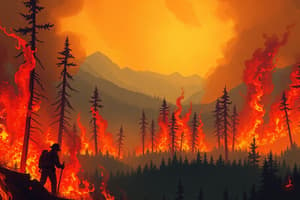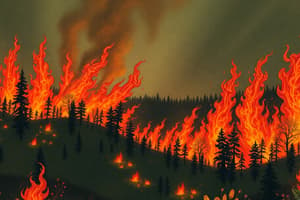Podcast
Questions and Answers
What is the main reason that 'zombie' fires can reignite after being thought to be extinguished?
What is the main reason that 'zombie' fires can reignite after being thought to be extinguished?
- They are sustained by flammable organic matter underground. (correct)
- They are caused by spontaneous combustion.
- They rely on regular rainfall to revive.
- They are triggered solely by human intervention.
Which method allows 'zombie' fires to re-emerge once they have been smoldering underground?
Which method allows 'zombie' fires to re-emerge once they have been smoldering underground?
- Heavy snowfall.
- High winds.
- Lightning strikes. (correct)
- Flooding.
How much land was scorched by wildfires in Canada during the worst wildfire season in record, 2023?
How much land was scorched by wildfires in Canada during the worst wildfire season in record, 2023?
- 30 million acres.
- 60 million acres.
- 20 million acres.
- 48 million acres. (correct)
What distinguishes peat fires from forest fires in terms of their burning pattern?
What distinguishes peat fires from forest fires in terms of their burning pattern?
What percentage increase in fires was observed in Canada from 2022 to 2023?
What percentage increase in fires was observed in Canada from 2022 to 2023?
What primarily allows zombie fires to remain active for years underground?
What primarily allows zombie fires to remain active for years underground?
Which of the following factors makes detecting zombie fires particularly challenging?
Which of the following factors makes detecting zombie fires particularly challenging?
What was a contributing factor to the surge in zombie fires in Canada in 2023?
What was a contributing factor to the surge in zombie fires in Canada in 2023?
Which geographical areas, besides Canada, are known to experience zombie fires?
Which geographical areas, besides Canada, are known to experience zombie fires?
How many zombie fires were reported in British Columbia in 2023?
How many zombie fires were reported in British Columbia in 2023?
Flashcards are hidden until you start studying
Study Notes
Zombie Fires
- Zombie fires are wildfires that smolder underground for extended periods, often for many years, fueled by highly flammable organic matter like peat.
- These fires can reignite when conditions change, such as when lightning strikes or when farmers set fires to burn excess vegetation.
- They are also known as holdover or overwintering fires.
Frequency and Location
- Zombie fires occur annually in British Columbia and Alberta, but usually no more than 15 per year.
- In 2023, a record surge in the number of zombie fires occurred, with over 93 reported in British Columbia and more than 55 in Alberta.
Cause of the Surge
- This increase in zombie fires is largely related to a prolonged drought in Canada, which has lasted for three years.
- Typically, melting snow extinguishes these fires, but recent lower precipitation and warmer winter temperatures have enabled the fires to continue burning in the dense vegetation layers below the snowpack.
Challenges in Detecting Zombie Fires
- The remote and inaccessible locations of many of these fires make detection difficult.
- The underground, flameless nature of these fires allows them to spread undetected over large areas.
- Frozen ground, covered with snow, hinders firefighting efforts.
Geographic Distribution
- Zombie fires are not unique to Canada; they are also found in similar environments in Alaska, Northern Europe, and Siberia.
- These regions share common characteristics, including cool coniferous forests with dense layers of needles and other vegetation, making them easily combustible.
Studying That Suits You
Use AI to generate personalized quizzes and flashcards to suit your learning preferences.





